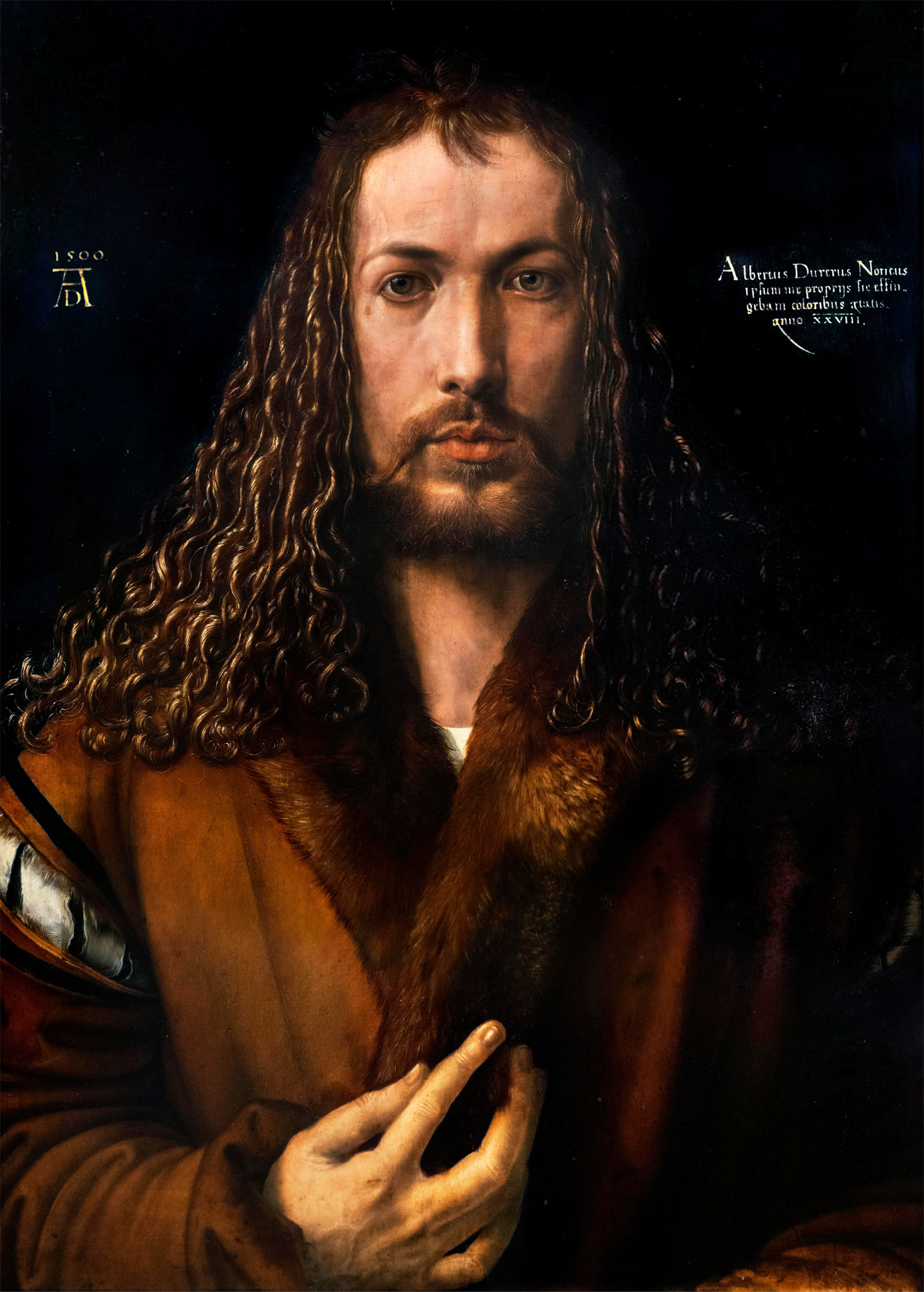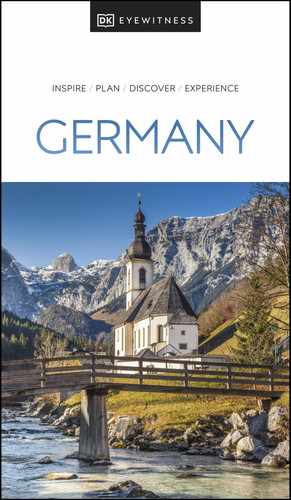
t Sunset over the rooftops of Nürnberg’s old town
Experience Bavaria

n Double-tap image to read the labels
The Frauentor (Ladies’ Tower) is one of the most attractive gates into the old town. It is installed in the massive city walls that were constructed during the 15th and 16th centuries. The vast tower, Dicker Turm (Fat Tower), was erected nearby in the 15th century. Königstor (King’s Tower), a magnificent gate that once stood to the right of Dicker Turm, was dismantled in the 19th century. Beyond Frauentor are a number of alleys with half-timbered houses, shops and cafés.
The massive structure that dominates Königstrasse is a Gothic granary built in 1498–1502 by German architect Hans Beheim the Elder. It originally housed the town’s municipal scales and the customs office. In the 19th century the building was converted into a department store and continues in that role today, following post-war reconstruction.
Overlooked by the church of St Lorenz, Lorenzer Platz is a popular meeting place for the citizens of Nürnberg and visitors alike. Outside the church is the Fountain of the Virtues, Tugendbrunnen (1589), with water cascading from the breasts of its seven Virtues. Nearby is a statue of St Lorenz, which is a copy of the 1350 Gothic original. Diagonally across the square is the Nassauer Haus, a Gothic mansion whose lower storeys were built in the 13th century. The upper floors were added in the 15th century.
A short distance from the square, in Karolinenstrasse, is a fine sculpture (Large Totem Head, 1968) by Henry Moore.
In the centre of town, on the banks of the River Pegnitz, stands the Hospital of the Holy Spirit. Founded in 1332, this is one of the largest hospitals built in the Middle Ages and features a lovely inner courtyard with wooden galleries. The wing that spans the river was built in 1488–1527. Lepers were kept at some distance from the other patients, in a separate half-timbered building that was specially erected for the purpose. From 1424 until 1796 the insignia of the Holy Roman Empire were kept here rather than in the castle.
The Heilig-Geist-Spital now houses a retirement home and a restaurant. The entrance to the building is on the northern side of the river.
Having spent much of his childhood in a house on the corner of Burgstrasse and Obere Schmiedgasse, the renowned German artist and engraver Albrecht Dürer later lived in this half-timbered house from 1509 until his death in 1528. It stands as Germany’s first artist’s memorial site.
On the 300th anniversary of his death, the building was bought by the town and many rooms have since been reconstructed. The third-floor room now contains a printing press dating from Dürer’s time. Copies of his pictures provide a useful insight into the work of this distinguished Nürnberg citizen.
Experience Bavaria
Albrecht Dürer

One of the most outstanding painters of the Renaissance era, Dürer began his career as a goldsmith in his father’s workshop. He achieved fame not only as a skilled painter, but also as a brilliant engraver and respected theoretician.
The present town hall consists of several sections. Facing the Rathausplatz is the oldest, Gothic part, built in 1332–40 and remodelled in the early 15th century. Behind, facing Hauptmarkt, is the Renaissance part, built in 1616–22 by Jakob Wolff. Its magnificent portals are decorated with heraldic motifs. The courtyard features a fountain dating from 1557.

t Gallery of artworks, Germanisches Nationalmuseum
This museum, which was officially opened in 1852, was founded by a Franconian aristocrat named Hans von Aufsess. It houses a unique collection of antiquities from the German-speaking world, including religious relics, artworks and old scientific equipment. In 1945, towards the end of World War II, parts of the buildings that had originally housed the museum were bombed. The architecture of the modern building, which was completed in 1993, cleverly incorporates the remaining fragments of a former Carthusian abbey. Among the most valuable items in the museum’s collection are works by Tilman Riemenschneider, Konrad Witz, Lucas Cranach the Elder, Albrecht Altdorfer, Albrecht Dürer and Hans Baldung Grien.
This enchanting toy museum, established in 1971, houses a magnificent collection of tin soldiers and a huge collection of dolls and puppets. Its greatest attraction, however, is a collection of antique dolls houses, filled with miniature furniture and equipment.
The three castles that tower over Nürnberg comprise the central burgraves’ castle, with the Free Reich’s buildings to the east, and the imperial castle (whose origins go back to the 12th century) to the west. When climbing up the Burgstrasse you will first reach the Fünfeckturm (Pentagonal Tower), which dates from 1040. The oldest building in town, it is an architectural relic of the von Zollern burgraves’ castle. At its foot are the Kaiserstallung (emperor’s stables), which now house a youth hostel. A further climb will bring you to the courtyard of the imperial palace, which features a round tower (Sinwellturm) dating from the 12th century, and a deep well – the Tiefe Brunnen. Passing through the inner gate of the castle you will finally reach its heart, the residential building.
Did You Know?
The Hauptmarkt hosts a weekly food market, as well as an annual flea market and an Easter market.

t Hauptmarkt’s Christmas market illuminated by festive lights
Each year the Hauptmarkt provides a picturesque setting for the town’s festive Christkindlesmarkt. Throughout Advent you can buy gingerbread, enjoy the taste of German sausages, warm yourself with a glass of mulled wine spiced with cloves and buy locally made souvenirs.
Nürnberg’s star attraction is the Gothic Schöner Brunnen (Beautiful Fountain), which was erected around 1385 but replaced in the early 20th century with a replica. It consists of a 19-m- (62-ft-) high, finely carved spire standing at the centre of an octagonal pool. The pool is surrounded by a Renaissance grille that includes a famous golden ring: the local tradition is that if you turn the ring three times, your wishes will come true.
The St John’s cemetery is one of the best preserved and most important in Europe. Established in 1518, it has provided a resting place for many illustrious citizens, including the painter Albrecht Dürer (No. 649), the sculptor Veit Stoss (No. 268), the goldsmith Wenzel Jamnitzer (No. 664) and the painter Anselm Feuerbach (No. 715). The cemetery also contains a rich array of tombs from the 16th, 17th and 18th centuries.
The Churches of Nürnberg
As a town brimming with historical sights, Nürnberg is home to many beautiful churches, each with its own character and treasures. The small hospital church of St Martha dates from the 14th century, and though almost devoid of furnishing, it has some magnificent Gothic stained-glass windows. Completed in 1273, Sebalduskirche is the oldest in town, and houses many beautiful relics, including the bronze tomb of St Sebald. Frauenkirche contains a clock that displays a procession of electors paying homage to the emperor every day at noon.
This vast, unfinished building complex in the southern part of town dates from the Nazi era, built for National Party gatherings. The building now houses a historical exhibition and archive, reminding and educating visitors of its horrifying past.
